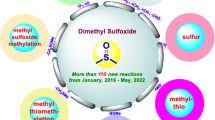Conclusions
-
1.
A new equilibrium reaction was found involving transformation of perfluoro-4-oxo-2,5-dimethyl-2-(2′-oxa-3′-fluorocarbonylbutyl)-1,3,-dioxolane into perfluoro-4-oxo-2,5-dimethyl-2-fluorocarbonyl-1, 3-dioxolane and perfluoro-2-oxo-3,6-dimethyl-1,4-dioxane. A scheme for the process is proposed.
-
2.
A catalytic ionic fragmentation was discovered of some perfluoro-4-oxo-1,3-dioxolanes containing a fluoroanhydride group to give trifluoroacetyl fluoride and carbon monoxide.
Similar content being viewed by others
Literature cited
S. Selman, Patent 3,475,456, USA, Chem. Abstrs.,72, 2167b.
R. Banes, E. D. Burling, B. A. Dodd, et al., J. Chem. Soc., C, 1706, (1969); R. Banes and K. Mullen, J. Chem. Soc. C., 2333 (1967).
V. S. Yuminov, S. V. Kartsov, V. L. Maksimov, and A. V. Fokin, Izv. Akad. Nauk SSSR, Ser. Khim., 392 (1988).
A. Gordon and R. Ford, Chemist's Companion, Wiley-Interscience, New York (1973).
K. Nakamoto, Infrared Spectra of Inorganic and Coordination Compounds, 2nd edn., Wiley-Interscience, New York (1970).
Author information
Authors and Affiliations
Additional information
Translated from Izvestiya Akademii Nauk SSSR, Seriya Khimicheskaya, No. 2, pp. 396–398, February, 1988.
Rights and permissions
About this article
Cite this article
Yuminov, V.S., Kartsov, S.V., Vinogradov, L.E. et al. Perfluorinated dioxolanes. 2. Reaction of perfluoro-4-oxo-1,3-dioxolanes with fluorine ion. Russ Chem Bull 37, 315–318 (1988). https://doi.org/10.1007/BF00957433
Received:
Issue Date:
DOI: https://doi.org/10.1007/BF00957433




